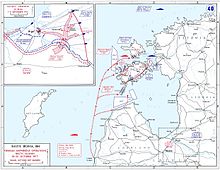
SMS Pillau was a light cruiser of the Imperial German Navy. The ship, originally ordered in 1913 by the Russian navy under the name Maraviev Amurskyy, was launched in April 1914 at the Schichau-Werke shipyard in Danzig. However, due to the outbreak of World War I in August 1914, the incomplete ship was confiscated by Germany and renamed SMS Pillau for the East Prussian port of Pillau. Pillau was commissioned into the German Navy in December 1914. She was armed with a main battery of eight 15 cm SK L/45 (5.9-inch) guns and had a top speed of 27.5 kn. One sister ship was built, Elbing.

SMS Kronprinz was the last dreadnought battleship of the four-ship König class of the German Imperial Navy. The battleship was laid down in November 1911 and launched on 21 February 1914. She was formally commissioned into the Imperial Navy on 8 November 1914, just over 3 months after the start of World War I. The name Kronprinz refers to Crown Prince Wilhelm, and in June 1918, the ship was renamed Kronprinz Wilhelm in his honor. The battleship was armed with ten 30.5-centimeter (12 in) guns in five twin turrets and could steam at a top speed of 21 knots.
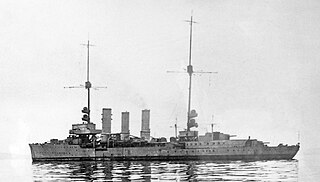
SMS Cöln was a light cruiser in the German Kaiserliche Marine, the second to bear this name, after her predecessor SMS Cöln had been lost in the Battle of Heligoland Bight. Cöln, first of her class, was launched on 5 October 1916 at Blohm & Voss in Hamburg and completed over a year later in January 1918. She and her sister Dresden were the last two light cruisers built by the Kaiserliche Marine; eight of her sisters were scrapped before they could be completed. The ships were an incremental improvement over the preceding Königsberg-class cruisers.
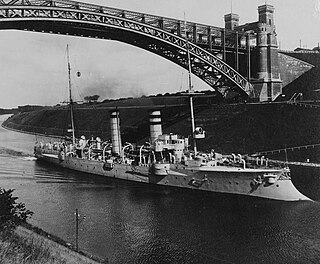
SMS Frauenlob was the eighth member of the ten-ship Gazelle class of light cruisers that were built for the German Kaiserliche Marine in the late 1890s and early 1900s. The Gazelle class was the culmination of earlier unprotected cruiser and aviso designs, combining the best aspects of both types in what became the progenitor of all future light cruisers of the Imperial fleet. Built to be able to serve with the main German fleet and as a colonial cruiser, she was armed with a battery of ten 10.5 cm (4.1 in) guns and a top speed of 21.5 knots. Frauenlob was a modified version of the basic Gazelle design, with improved armor and additional coal storage for a longer cruising range.

SMS Frankfurt was a light cruiser of the Wiesbaden class built by the German Kaiserliche Marine. She had one sister ship, SMS Wiesbaden; the ships were very similar to the previous Karlsruhe-class cruisers. The ship was laid down in 1913, launched in March 1915, and completed by August 1915. Armed with eight 15 cm SK L/45 guns, Frankfurt had a top speed of 27.5 knots and displaced 6,601 t at full load.

SMS Stralsund was a Magdeburg-class light cruiser of the German Kaiserliche Marine. Her class included three other ships: Magdeburg, Breslau, and Strassburg. She was built at the AG Weser shipyard in Bremen from 1910 to December 1912, when she was commissioned into the High Seas Fleet. The ship was armed with a main battery of twelve 10.5 cm SK L/45 guns and had a top speed of 27.5 knots.

SMS Stettin was a Königsberg-class light cruiser of the Kaiserliche Marine. She had three sister ships: Königsberg, Nürnberg, and Stuttgart. Laid down at AG Vulcan Stettin shipyard in 1906, Stettin was launched in March 1907 and commissioned into the High Seas Fleet seven months later in October. Like her sisters, Stettin was armed with a main battery of ten 10.5 cm (4.1 in) guns and a pair of 45 cm (18 in) torpedo tubes, and was capable of a top speed in excess of 25 knots.

SMS Yorck was the second and final ship of the Roon class of armored cruisers built for the German Kaiserliche Marine as part of a major naval expansion program aimed at strengthening the fleet. Yorck was named for Ludwig Yorck von Wartenburg, a Prussian field marshal. She was laid down in 1903 at the Blohm & Voss shipyard in Hamburg, launched in May 1904, and commissioned in November 1905. The ship was armed with a main battery of four 21 cm (8.3 in) guns and had a top speed of 20.4 knots. Like many of the late armored cruisers, Yorck was quickly rendered obsolescent by the advent of the battlecruiser; as a result, her peacetime career was limited.

SMS Karlsruhe was a light cruiser of the Königsberg class, built for the Kaiserliche Marine during World War I. She was named after the earlier Karlsruhe, which had sunk in November 1914, from an accidental explosion. The new cruiser was laid down in 1914 at the Kaiserliche Werft shipyard in Kiel, launched in January 1916, and commissioned into the High Seas Fleet in November 1916. Armed with eight 15 cm SK L/45 guns, the ship had a top speed of 27.5 kn.

SMS Nürnberg was a Königsberg-class light cruiser built during World War I by Germany for the Imperial Navy. She had three sisters: Königsberg, Karlsruhe, and Emden. The ship was named after the previous light cruiser Nürnberg, which had been sunk at the Battle of the Falkland Islands. The new cruiser was laid down in 1915 at the AG Weser shipyard in Bremen, launched in April 1916, and commissioned into the High Seas Fleet in February 1917. Armed with eight 15 cm (5.9 in) SK L/45 guns, the ship had a top speed of 27.5 kn.
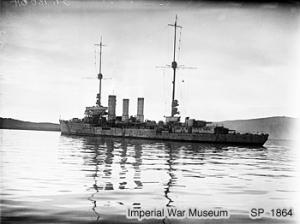
SMS Emden was a German light cruiser belonging to the Königsberg class, built during the First World War. Emden served in the German Kaiserliche Marine until the end of the war, at which point she was ceded to France. The ship was named after the previous Emden, which had been destroyed at the Battle of Cocos earlier in the war. She mounted an Iron Cross on her stem-head in honor of the earlier Emden. The new cruiser was laid down in 1914 at the AG Weser shipyard in Bremen, launched in February 1916, and commissioned into the High Seas Fleet in December 1916. Armed with eight 15 cm SK L/45 guns, the ship had a top speed of 27.5 kn.

SMS Graudenz was the lead ship of her class of light cruisers. She had one sister ship, SMS Regensburg. The ship was built by the German Kaiserliche Marine in the Kaiserliche Werft shipyard in Kiel, laid down in 1912 and commissioned into the High Seas Fleet in August 1914, days after the outbreak of World War I. She was named for the then-German town of Graudenz. The ship was armed with a main battery of twelve 10.5 cm SK L/45 guns and had a top speed of 27.5 knots.

SMS Brummer was a minelaying light cruiser of the German Kaiserliche Marine; she was the lead ship of her class. Her sister ship was Bremse. Brummer was laid down at AG Vulcan's shipyard in Stettin, Germany, on 24 April 1915 and launched on 11 December 1915 and completed on 2 April 1916. Armed with a main battery of four 15-centimeter (5.9 in) guns in single mounts, she carried 400 mines.

SMS Regensburg was a light cruiser of the Graudenz class built by the German Kaiserliche Marine. She had one sister ship, SMS Graudenz. The ship was built by the AG Weser shipyard in Bremen, laid down in 1912, launched in April 1914, and commissioned into active service in January 1915. She was named for the German town of Regensburg. The ship was armed with a main battery of twelve 10.5 cm SK L/45 guns and had a top speed of 27.5 knots, though in 1917 she was rearmed with seven 15 cm SK L/45 guns.

SMS Kolberg was a light cruiser of the German Kaiserliche Marine during the First World War, the lead ship of her class. She had three sister ships, SMS Mainz, Cöln, and Augsburg. She was built by the Schichau-Werke; her hull was laid down in early 1908 and she was launched later that year, in November. She was commissioned into the High Seas Fleet in June 1910. She was armed with a main battery of twelve 10.5 cm SK L/45 guns and had a top speed of 25.5 kn.

SMS Kaiserin was the third vessel of the Kaiser class of dreadnought battleships of the Imperial German Navy. Kaiserin's keel was laid in November 1910 at the Howaldtswerke dockyard in Kiel. She was launched on 11 November 1911 and was commissioned into the fleet on 14 May 1913. The ship was equipped with ten 30.5-centimeter (12 in) guns in five twin turrets, and had a top speed of 22.1 knots. Kaiserin was assigned to III Battle Squadron and later IV Battle Squadron of the High Seas Fleet for the majority of her career, including World War I.

SMS Danzig was a light cruiser of the Imperial German Navy. Named for the city of Danzig, she was the seventh and last ship of the Bremen class. She was begun by the Imperial Dockyard in her namesake city in 1904, launched on 23 September 1905 and commissioned on 1 December 1907. Armed with a main battery of ten 10.5 cm (4.1 in) guns and two 45 cm (18 in) torpedo tubes, Danzig was capable of a top speed of 22 knots.

SMS Augsburg was a Kolberg-class light cruiser of the German Kaiserliche Marine during the First World War. She had three sister ships, SMS Kolberg, Mainz, and Cöln. The ship was built by the Kaiserliche Werft in Kiel; her hull was laid down in 1908 and she was launched in July 1909. Augsburg was commissioned into the High Seas Fleet in October 1910. She was armed with a main battery of twelve 10.5 cm SK L/45 guns and had a top speed of 25.5 knots.
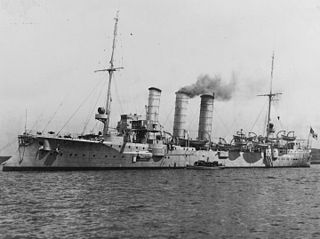
SMS München was the fifth of seven Bremen-class cruisers of the Imperial German Navy, named after the city of Munich. She was built by AG Weser in Bremen, starting in 1903, launched in April 1904, and commissioned in January 1905. Armed with a main battery of ten 10.5 cm (4.1 in) guns and two 45 cm (18 in) torpedo tubes, München was capable of a top speed of 22.5 knots.
SMS Stuttgart was a Königsberg-class light cruiser of the Kaiserliche Marine, named after the city of Stuttgart. She had three sister ships: Königsberg, Nürnberg, and Stettin. Stuttgart was laid down at the Imperial Dockyard in Danzig in 1905, launched in September 1906, and commissioned in February 1908. Like her sisters, Stettin was armed with a main battery of ten 10.5 cm (4.1 in) guns and a pair of 45 cm (18 in) torpedo tubes, and was capable of a top speed in excess of 25 knots.

